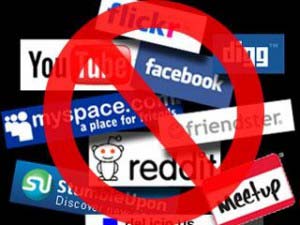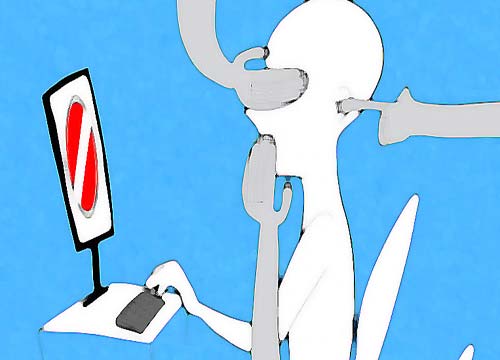Gagging mass media has been an age old practice to stop people from knowing what they are supposed to. With internet, a new edifice of social information emerged. But managing it is pretty easier because it involves just one switch, Tasavur Mushtaq reports.
On February 9, 2013, when news of Afzal Guru’s execution was made public, what followed was curfew and protests. A series of measures that authorities took included a media ‘gag’. Newspapers were advised against printing, cable news channels were disrupted and the internet services were downed. The internet on broadband was slowed down. For many days, the people had a new priority that the systems fixed: to know a bit of information. It was onset of the Stone Age for many days.
This has been a time tested tool. It happened in 2008, 2009, and 2010. For many people, it was reminiscent of 1975, when emergency was declared in India. “When a regime stops or filters information, it can claim to be anything but not democratic,” a Facebook status of a scribe read.
Restricting movement of people has been a routine in the valley since 1990s. Intermittently, the government did intervene in stopping media. At one point of time, the then governor Jagmohan sealed the printing presses and later forcibly deported all the foreign journalists from Kashmir. The objective was clear; let the local population not know what is happening and let nobody overseas know it as well.
Unlike past, the tools of information are quite huge now and therefore controlling all of them becomes difficult. Internet is the main mover of information. Then there are cell phones and in Kashmir, nearly two-third population has subscribed to this facility.
=Blocking new media was successfully tested in 2008 when Amarnath land row erupted after the PDP-Congress coalition government led by Ghulam Nabi Azad diverted a piece of 100 acre land to the Shri Amarnathji Shrine Board. The decision evoked huge resentment from the people and protests started, which led to the fall of Azad government. Sensing trouble, the order was rescinded on July 1, 2008.
The decision of cancellation had its repercussions in Jammu. It triggered a counter-agitation that lasted for more than two months and in between the right-wingers enforced economic blockade on the valley.
The government, in desperate attempts to curb the protests, felt that SMS service was inciting the people to take to streets, so it became the first causality. SMS service were banned “in the interest of security” by the union home ministry in mid-July, 2008. The decision hit nearly 3.5 million mobile subscribers. After the agitation was over, the ban was lifted on August 31, 2008 but only for post paid subscribers.
= The second on the list were the ‘other media’ – mostly the cable news channels that had mushroomed in Jammu and Kashmir. Authorities asked them not to broadcast anything that relates to current happenings and restrict themselves to culture and entertainment. The government claimed that these “channels” violated the Cable Television Network (Regulation) Act 1995.
The operators protested and in retaliation snapped the telecast of all national and international news channels to the poor subscribers till the government finally allowed them to telecast news and current affairs programs after about two weeks.
In September 2008, the state government again directed private channel owners to go off the air. To implement the order, police raided the offices of private channels and seized all the equipment which was used to telecast programs, including news.
Although the ban on private channels was meant for both the regions of the state, in Jammu, the ban was immediately lifted while in Kashmir, it was lifted a month after the summer agitation ended that year.
In 2009, when the twin “rape and murder” case in Shopian brought people on the streets, the same model was followed. The local cable operators again found themselves at the receiving end. They were asked to reduce the airtime of news. The cable operators complied. This time, not only SMS service but entire pre paid services were withdrawn. The move denied many people a tool of communication.
The biggest blow, however, came during 2010 summer uprising in which more than 122 youth were shot dead by various police and paramilitary forces. The government initially issued several ‘advisories’ to the local cable channels to ‘tone down’ their coverage. This was followed by a missive in June, directing all local channels that they lack legal sanctity for dabbling into current affairs. As the situation worsened, the channels were asked to stop broadcasting news altogether on September 12, 2010. However, there was no such ban on cable operators in Jammu province of the state. “Why cable channels in Jammu are allowed to function smoothly, while there is a ban on news channels in Kashmir?”asks one of the owners of SEN channel, Amjad Hussain.
“We have told the cable operators to adhere to the Cable Network Act (1995) in letter and spirit as under this act they can’t telecast news,” the then Deputy Commissioner Srinagar, Mehraj Ahmad Kakroo, had told the local media.
To have a deterrent, the state police also registered an FIR against the television channel and its correspondents for running “baseless news” about the death of a youth in police firing in Pulwama town. Chief Minister Omar Abdullah personally stated repeatedly that his government will not allow local cable channels to broadcast news. But the same decision did not apply to the cable operators in Jammu.
With government curbing the news channels, mobile services and newspapers, Kashmiris who have always found novel ways of expression despite curbs throughout their history started using virtual world to remain in touch with the outside world.
From Facebook to Twitter to Orkut; online news reading to e-book reading; chatting to downloading, Kashmiris were hooked to the web. Net-savvy culture cropped up in Kashmir termed as Facebook Tehreek, putting government in a quandary.
After denying the physical space, the government started to shrink the virtual space as well. As there has been a marked increase in people taking to protesting on the internet, the government launched a crackdown on people, especially youth who used internet to upload protest videos and making what police calls “provocative” statements on Facebook. “Nearly 400 protest videos were uploaded on Youtube in nearly 30 days,” said one of the blogger.
To start with, tech savvy Mirwaiz of south Kashmir, Qazi Yasir, was booked under Public Safety Act for “instigating violence through Facebook,” besides making “hate speeches in public.”
It did not stop here. Many social media activists were seen actively involved. Names like Freedom of Dawn, Aalaw (The Call), Hoshar Jamat (Awakened Group), Balayi Khuda (God’s Wrath), We Love Syed Ali Shah Geelani, Kale Kharaab (Hot Headed), Quaid Inqilab Syed Ali Geelani, to name a few, compelled the police to activate their tech savvy personnel who otherwise had no active role.
After Qazi Yasir, police arrested a bank employee, Mufti Wajid Yaqoob, from south Kashmir’s Shopian district on October, 10, 2010, under Public Safety Act. Administrators of many different pages were summoned to the concerned police stations for ‘counseling’.
It was a recap when after apparent calm of two years that on February 9, 2013 Kashmir again witnessed curbs on means of disseminating the information. In the aftermath of Afzal Guru’s hanging, the media houses received unofficial gag order not to make any effort to print newspapers. Publications which printed were seized. Local cable service remained off air. This time even Delhi based news channels were snapped. The internet services were put to halt, denying people a chance to even read online edition of newspapers. However, entertainment, sports and movie channels were functioning normally.
“Such curtailments go against International Covenant on Civil and Political Rights and Universal Declaration of Human Rights,” noted pediatrician and civil society activist, Dr Altaf Hussain told a seminar in Srinagar.
The state government did not buy the argument of media houses that they were restricted to go for printing. “There is no ban on newspapers in Kashmir. Newspapers are choosing not to print because restrictions make delivery of newspapers impossible,” tech savvy Chief Minister tweeted.
The editor of the English daily, Rising Kashmir, Shujaat Bukahri said, “The police parties visited the offices and printing press of newspapers including mine. They did not have any official orders. They told us that there was no use publishing the next day’s edition as it would not be delivered to people due to curfew.”
Many believe that Omar is not the first one to impose ban, but it dates back to era of his grandfather Sheikh Muhammad Abdullah as well. “It dates back to the time of Sheikh Abdullah, grandfather of chief minister. There was nothing but radio sets in the name of mass media. The government used to confiscate them in days of tension,” Showkat Motta, the editor of English daily, Kashmir Reader, said.

















Apt.
Hitler was not blamed for being atrocious.
See how ‘democratically’ elected representatives are behaving.
Disgusting.
This is what they have been doing to Kashmir, after squeezing our space to represent ourselves at every front.
Whatever, they cannot suppress what is in our heart.